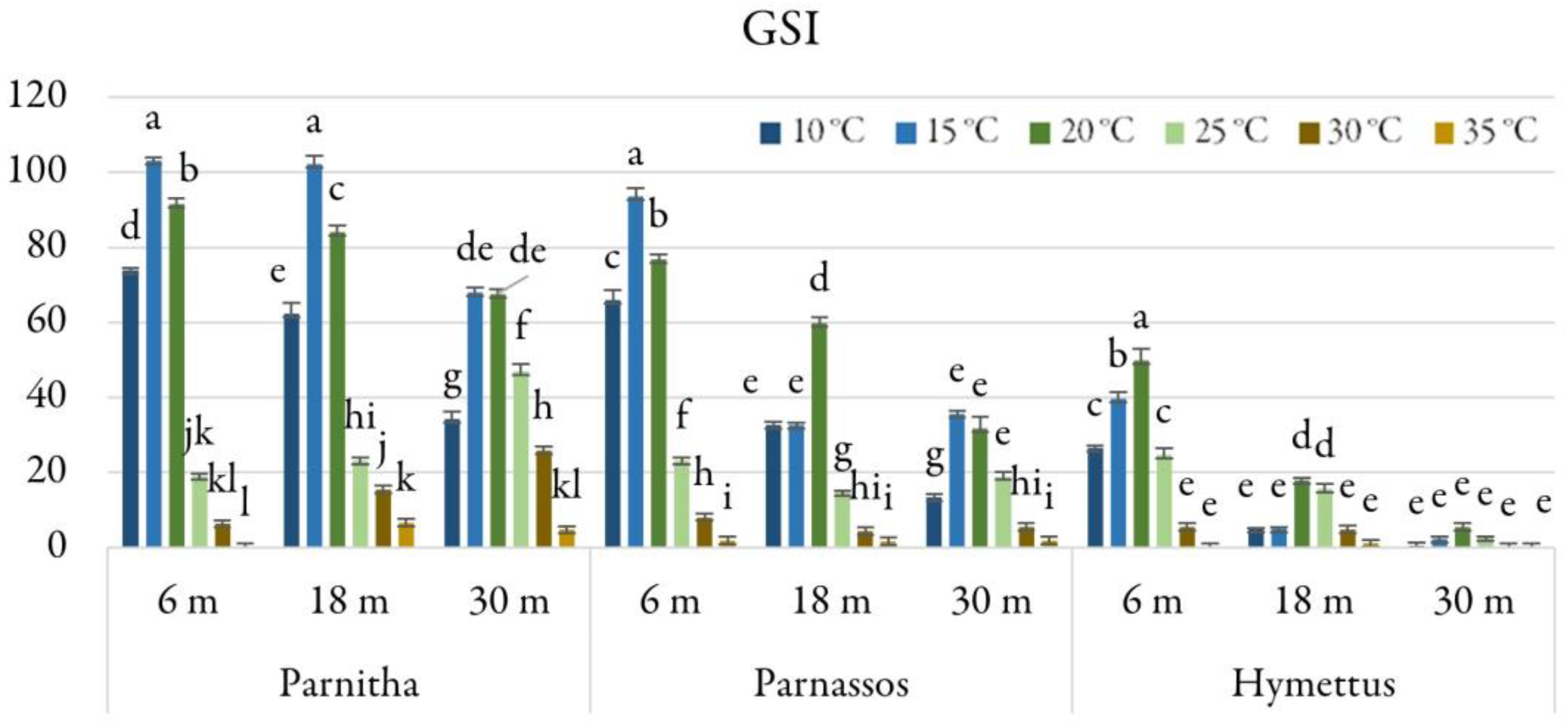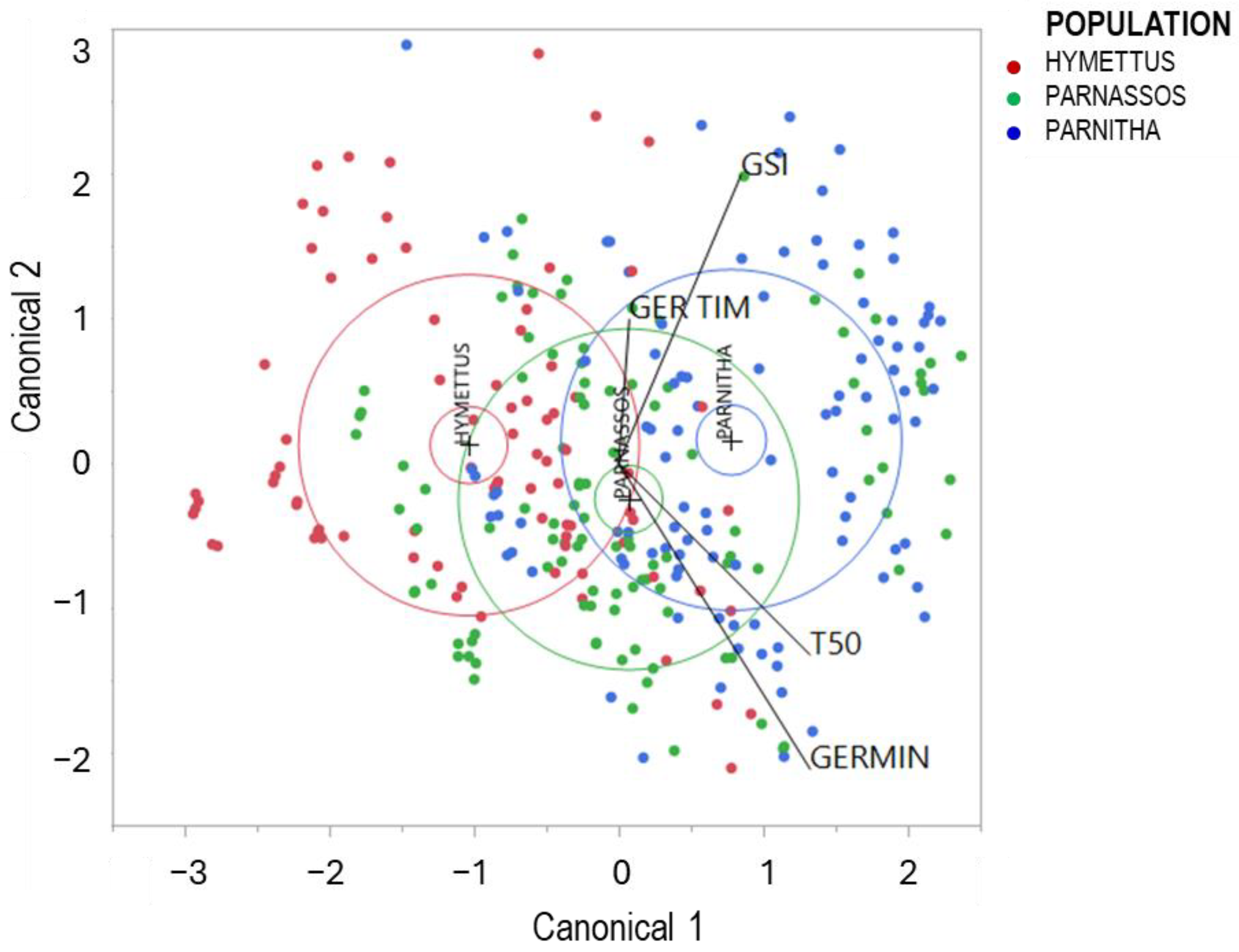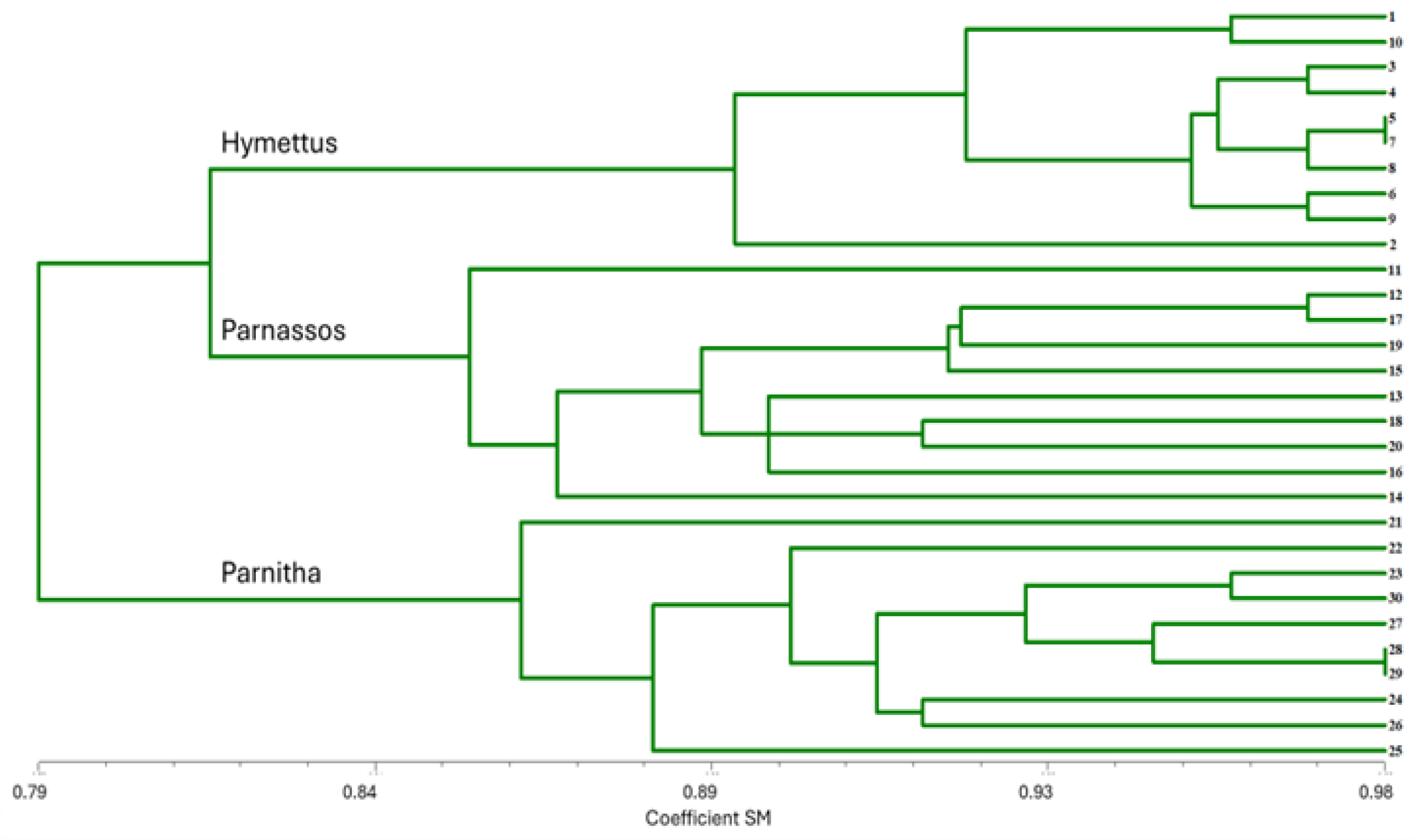In Vitro Seed Germination and RAPD Variation in Three Populations of Cerastium candidissimum Correns, a Promising Ornamental Species
Abstract
1. Introduction
2. Materials and Methods
2.1. Seed Collection
2.2. In Vitro Germination
2.3. DNA Extraction and RAPD Analysis
2.4. Data Collection and Statistical Analysis
3. Results
3.1. In Vitro Germination
3.2. DNA Extraction and RAPD Analysis
4. Discussion
5. Conclusions
Author Contributions
Funding
Data Availability Statement
Conflicts of Interest
References
- Heywood, V.; Skoula, M. The MEDUSA Network: Conservation and sustainable use of wild plants of the Mediterranean region. In Perspectives on New Crops and New Uses; Kanick, J., Ed.; ASHS Press: Alexandria, VA, USA, 1999; pp. 148–151. [Google Scholar]
- Krigas, N.; Tsoktouridis, G.; Anestis, I.; Khabbach, A.; Libiad, M.; Megdiche-Ksouri, W.; Ghrabi-Gammar, Z.; Lamchouri, F.; Tsiripidis, I.; Tsiafouli, M.A.; et al. Exploring the potential of neglected local endemic plants of three Mediterranean regions in the ornamental sector: Value chain feasibility and readiness timescale for their sustainable exploitation. Sustainability 2021, 13, 2539. [Google Scholar] [CrossRef]
- Iatrou, G. The richness and the rarity of the Greek flora. In Directive 92/43/EEC: The Greek Habitat Project Natura 2000: An Overview; Dafis, S., Papastergiadou, E., Georgiou, K., Babalonas, D., Georgiadis, T., Papageorgiou, M., Lazaridou, T., Tsiaoussi, V., Eds.; Life Contract B4-3200/94/756, Commission of the European Communities DG XI, The Goulandris Natural History Museum-Greek Biotope/Wetland Centre: Thessaloniki, Greece, 1996; pp. 437–438. [Google Scholar]
- Bittrich, V. Caryophyllaceae. In Flowering Plants: Dicotyledons—Magnoliid, Hamamelid, and Caryophyllid Families; Kubitzki, K., Rohwer, J.G., Bittrich, V., Eds.; Springer: Berlin, Germany, 1993; pp. 206–236. [Google Scholar]
- Greenberg, A.K.; Donoghue, M.J. Molecular systematics and character evolution in Caryophyllaceae. Taxon 2011, 60, 1637–1652. [Google Scholar] [CrossRef]
- World Flora Online (WFO). Available online: http://www.worldfloraonline.org (accessed on 2 July 2024).
- Niketić, M.; Siljak-Yakovlev, S.; Frajman, B.; Lazarević, M.; Stevanović, B.; Tomović, G.; Stevanović, V. Towards resolving the systematics of Cerastium subsection Cerastium (Caryophyllaceae): A cytogenetic approach. Bot. J. Linn. Soc. 2013, 172, 205–224. [Google Scholar] [CrossRef]
- Surina, B.; Schönswetter, P.; Schneeweiss, G.M. Quaternary range dynamics of ecologically divergent species (Edraianthus serpyllifolius and E. tenuifolius, Campanulaceae) within the Balkan refugium. J. Biogeog. 2011, 38, 1381–1393. [Google Scholar] [CrossRef]
- Dimopoulos, P.; Raus, T.; Bergmeier, E.; Constantinidis, T.; Iatrou, G.; Kokkini, S.; Strid, A.; Tzanoudakis, D. Vascular Plants of Greece: An Annotated Checklist; Botanic Garden and Botanical Museum Berlin-Dahlem; Hellenic Botanical Society: Athens, Greece, 2013. [Google Scholar]
- Dimopoulos, P.; Raus, T.; Bergmeier, E.; Constantinidis, T.; Iatrou, G.; Kokkini, S.; Strid, A.; Tzanoudakis, D. Vascular plants of Greece: An annotated checklist—Supplement. Willdenowia 2016, 46, 301–347. [Google Scholar] [CrossRef]
- Khalaf, M.; Stace, C.A. The distinction between Cerastium tomentosum L. and C. biebersteinii DC. (Caryophyllaceae), and their occurrence in the wild in Britain. Watsonia 2001, 23, 481–491. [Google Scholar]
- Rice, G. RHS Encyclopedia of Perennials; Dorling Kindersley: London, UK, 2011; p. 496. [Google Scholar]
- Oschmann, C.; Kobayashi, N.; Perkuhn, C.; Grüneberg, H.; Wissemeier, A.H. Study to expand the range of wild plants for extensive roof greening systems using superabsorbent polymers (SAP). Acta Hortic. 2009, 813, 421–426. [Google Scholar] [CrossRef]
- Staats, D.; Klett, J.E. Water conservation potential and quality of non-turf groundcovers versus Kentucky bluegrass under increasing levels of drought stress. J. Environ. Hortic. 1995, 13, 181–185. [Google Scholar] [CrossRef]
- Verlinden, M.; Nijs, I. Alien plant species favored over congeneric natives under experimental climate warming in temperate Belgium. Biol. Invasions 2010, 12, 2777–2787. [Google Scholar] [CrossRef]
- Strid, A. Flora Hellenica; Koeltz Scientific Books: Koenigstein, Germany, 1997; p. 547. [Google Scholar]
- Khalaf, M.K. Biosystematic Studies in Cerastium tomentosum Group (Caryophyllaceae). Ph.D. Thesis, University of Leicester, Leicester, UK, 1993. Available online: https://hdl.handle.net/2381/35321 (accessed on 23 December 2022).
- Hayes, A. Cerastium candidissimum. 2017. Available online: https://www.anniesannuals.com/plants/view/?id=2132 (accessed on 10 September 2024).
- Krigas, N.; Menteli, V.; Vokou, D. The electronic trade in Greek endemic plants: Biodiversity, commercial, and legal aspects. Econ. Bot. 2014, 68, 85–95. [Google Scholar] [CrossRef]
- Darras, A.I. Implementation of sustainable practices in ornamental plant cultivation worldwide: A critical review. Agronomy 2020, 10, 1570. [Google Scholar] [CrossRef]
- Kougioumoutzis, K.; Kokkoris, I.P.; Panitsa, M.; Strid, A.; Dimopoulos, P. Extinction risk assessment of the Greek endemic flora. Biology 2021, 10, 195. [Google Scholar] [CrossRef]
- Samaropoulou, S. Cytological Study of Endemic and Rare Plants in Kefalonia. Master’s Thesis, Patras University, Patras, Greece, 2014. (In Greek). [Google Scholar]
- Bertsouklis, K.; Tsopela, S. In Vitro propagation of three populations of the endangered Greek endemic Cerastium candidissimum and short-term storability of alginate-encapsulated shoot explants for exploitation and conservation. Horticulturae 2023, 9, 273. [Google Scholar] [CrossRef]
- Hartmann, H.T.; Kester, D.E.; Geneve, R.L. Hartmann & Kester’s Plant Propagation: Principles and Practices, 8th ed.; Prentice Hall: Hoboken, NJ, USA, 2014. [Google Scholar]
- Cabahug, R.A.M.; Nam, S.Y.; Lim, K.B.; Jeon, J.K.; Hwang, Y.J. Propagation techniques for ornamental succulents. Kor. Fl. Assoc. 2018, 26, 90–101. [Google Scholar] [CrossRef]
- Bertsouklis, K.; Theodorou, P.; Aretaki, P.-E. In vitro propagation of the Mount Parnitha endangered species Sideritis raeseri subsp. attica. Horticulturae 2022, 8, 1114. [Google Scholar] [CrossRef]
- Bertsouklis, K.; Vlachou, G.; Trigka, M.; Papafotiou, M. In Vitro studies on seed germination of the Mediterranean species Anthyllis barba-jovis to facilitate its introduction into the floriculture industry. Horticulturae 2022, 8, 889. [Google Scholar] [CrossRef]
- Bertsouklis, K.; Naksi, K.; Aretaki, P.-E. In vitro germination and regeneration of Senna artemisioides, a valuable leguminous ornamental shrub. Not. Bot. Horti. Agrobot. Cluj. Napoca 2023, 51, 12992. [Google Scholar] [CrossRef]
- Bertsouklis, K.; Trigka, M.; Bazanis, A.E.; Akoumianaki-Ioannidou, A. In Vitro germination and micropropagation of the Balkan endemic Lilium chalcedonicum L., a potential ornamental lily. Not. Bot. Horti. Agrobot. Cluj. Napoca 2024, 52, 13596. [Google Scholar] [CrossRef]
- Pipinis, E.; Stampoulidis, A.; Kotoula, A.A.; Milios, E.; Kostas, S.; Hatzilazarou, S.; Papaioannou, E.; Papaeirinaios, A.; Kitikidou, K.; Radoglou, K. Seed germination behavior and molecular analysis of four populations of Arbutus andrachne species from Greece and cultivation practices for producing high-quality plants. Agriculture 2023, 13, 1428. [Google Scholar] [CrossRef]
- Alexopoulos, A.A.; Mavrommati, E.; Kartsonas, E.; Petropoulos, S.A. Effect of temperature and sucrose on in vitro seed germination and bulblet production of Pancratium maritimum L. Agronomy 2022, 12, 2786. [Google Scholar] [CrossRef]
- Bazanis, A.-E.; Papafotiou, M. In Vitro germination, micropropagation, and addressing hyperhydricity in the Balkan native Dianthus cruentus, a plant with high ornamental and xeriscaping potential. Horticulturae 2024, 10, 813. [Google Scholar] [CrossRef]
- Society for Ecological Restoration. International Network for Seed-Based Restoration and Royal Botanic Gardens Kew. Seed Information Database (SID). Available online: https://ser-sid.org/ (accessed on 27 February 2025).
- Pence, V.C. In vitro collecting (IVC). I. The effect of collecting method and antimicrobial agents on contamination in temperate and tropical collections. In Vitro Cell. Dev. Biol. Plant 2005, 41, 324–332. [Google Scholar] [CrossRef]
- Walters, C.; Wheeler, L.M.; Grotenhuis, J.M. Longevity of seeds stored in a genebank: Species characteristics. Seed Sci. Res. 2005, 15, 1–20. [Google Scholar] [CrossRef]
- Baskin, C.C.; Baskin, J.M. Breaking seed dormancy during dry storage: A useful tool or major problem for successful restoration via direct seeding? Plants 2020, 9, 636. [Google Scholar] [CrossRef] [PubMed]
- Fišer-Pečnikar, Ž.; Balant, M.; Glasnović, P.; Surina, B. Seed dormancy and germination of the rare, high-elevation Balkan endemic Cerastium dinaricum (Caryophyllaceae). Biologia 2018, 73, 937–943. [Google Scholar] [CrossRef]
- Vlachou, G.; Martini, A.Ν.; Dariotis, Ε.; Papafotiou, Μ. Comparative evaluation of seed germination of five Mediterranean sage species (Salvia sp.) native to Greece. Acta Hortic. 2020, 1298, 593–598. [Google Scholar] [CrossRef]
- Stoian-Dod, R.L.; Dan, C.; Morar, I.M.; Sestras, A.F.; Truta, A.M.; Roman, G.; Sestras, R.E. Seed germination within genus Rosa: The complexity of the process and influencing factors. Horticulturae 2023, 9, 914. [Google Scholar] [CrossRef]
- Sarropoulou, V.; Krigas, N.; Tsoktouridis, G.; Maloupa, E.; Grigoriadou, K. Seed germination trials and ex situ conservation of local prioritized endemic plants of Crete (Greece) with commercial interest. Seeds 2022, 1, 279–302. [Google Scholar] [CrossRef]
- Giménez-Benavides, L.; Escudero, A.; Pérez-García, F. Seed germination of high mountain Mediterranean species: Altitudinal, interpopulation, and interannual variability. Ecol. Res. 2005, 20, 433–444. [Google Scholar] [CrossRef]
- Sarasan, V.; Kite, G.C.; Sileshi, G.W.; Stevenson, P.C. Applications of phytochemical and in vitro techniques for reducing over-harvesting of medicinal and pesticidal plants and generating income for the rural poor. Plant Cell Rep. 2011, 30, 1163–1172. [Google Scholar] [CrossRef]
- Williams, J.G.K.; Kubelik, A.R.; Livak, K.J.; Rafalski, J.A.; Tingey, S.V. DNA polymorphisms amplified by arbitrary primers are useful as genetic markers. Nucl. Acids Res. 1990, 18, 6531–6535. [Google Scholar] [CrossRef] [PubMed]
- Hussain, H.; Nisar, M. Assessment of plant genetic variations using molecular markers: A review. J. Appl. Biol. Biotechnol. 2020, 8, 99–109. [Google Scholar] [CrossRef]
- Vázquez, J.L.H.; Gómez-Mercado, F.; Guerrero, J.-L.G.; Rodríguez-García, I.; García-Maroto, F. Genetic relationships and population structure within taxa of the endemic Sideritis pusilla (Lamiaceae) assessed using RAPDs. Botanical Bot. J. Linn. Soc. 1999, 129, 345–358. [Google Scholar] [CrossRef]
- Parab, G.; Krishnan, S. Assessment of genetic variation among populations of Rhynchostylis retusa, an epiphytic orchid from Goa, India, using ISSR and RAPD markers. Ind. J. Biotechnol. 2008, 7, 313–319. [Google Scholar]
- Boulila, A.; Béjaoui, A.; Messaoud, C.; Machraoui, M.; Boussaid, M. Genetic diversity and population structure of Teucrium polium (Lamiaceae) in Tunisia. Biochem. Genet. 2010, 48, 57–70. [Google Scholar] [CrossRef]
- Bertsouklis, K.F.; Papafotiou, M. Morphometric and molecular analysis of the three Arbutus species of Greece. Not. Bot. Horti. Agrobot. Cluj. Napoca 2016, 44, 423–430. [Google Scholar] [CrossRef]
- Ramesh, P.; Mallikarjuna, G.; Sameena, S.; Kumar, A.; Gurulakshmi, K.; Reddy, B.V.; Reddy, P.C.O.; Sekhar, A.C. Advancements in molecular marker technologies and their applications in diversity studies. J. Biosci. 2020, 45, 123. [Google Scholar] [CrossRef]
- Oliya, B.K.; Chand, K.; Thakuri, L.S.; Baniya, M.K.; Sah, A.K.; Pant, B. Assessment of genetic stability of micropropagated plants of Rhynchostylis retusa (L.) using RAPD markers. Sci. Horticult. 2021, 281, 110008. [Google Scholar] [CrossRef]
- Hagen, A.R.; Giese, H.; Brochmann, C. Trans-Atlantic dispersal and phylogeography of Cerastium arcticum (Caryophyllaceae) inferred from RAPD and SCAR markers. Am. J. Bot. 2001, 88, 103–112. [Google Scholar] [CrossRef]
- ENSCONET. Seed Collecting Manual for Wild Species; Royal Botanic Gardens, Kew (UK), Universidad Politécnica de Madrid (Spain), Eds.; ENSCONET: Richmond, UK, 2009; pp. 1–36. [Google Scholar]
- Murashige, T.; Skoog, F. A revised medium for rapid growth and bioassays with tobacco tissue cultures. Physiol. Plant. 1962, 15, 473–497. [Google Scholar] [CrossRef]
- Bertsouklis, K.; Panagaki, K.-P. In Vitro germination and propagation of Dyckia brevifolia, an ornamental and endangered bromeliad. Horticulturae 2022, 8, 390. [Google Scholar] [CrossRef]
- International Seed Testing Association. International rules for seed testing. Seed Sci. Technol. 1999, 27, 333. [Google Scholar]
- Soltani, A.; Galeshi, S.; Zeinali, E.; Latifi, N. Genetic variation for and interrelationships among seed vigor traits in wheat from the Caspian Sea coasts of Iran. Seed Sci. Technol. 2001, 29, 653662. [Google Scholar]
- Maguire, J.D. Speed of germination—Aid in selection and evaluation for seedling emergence and vigor. Crop Sci. 1962, 2, 176–177. [Google Scholar] [CrossRef]
- Li, L.; Boyd, C.E.; Odom, J.; Dong, S. Identification of Ictalurid catfish fillets to rearing location using elemental profiling. J. World Aquac. Soc. 2013, 44, 405–414. [Google Scholar] [CrossRef]
- Khemiri, S.; Gaamour, A.; Ben Abdallah, L.; Fezzani, S. The use of otolith shape to determine stock structure of Engrauli sencrasicolus along the Tunisian coast. Hydrobiologia 2018, 821, 73–82. [Google Scholar] [CrossRef]
- Stavrakakis, M.N.; Biniari, K. Genetic study of the grape cultivars belonging to the muscat family by random amplified polymorphic DNA markers. Vitis 1998, 37, 119–122. [Google Scholar]
- Rohlf, F.J. NTSYS-pc: Numerical Taxonomy and Multivariate Analysis System, Version 1.80; Exeter Software: Setauket, NY, USA, 1992. [Google Scholar]
- Sokal, R.R.; Sneath, P.H. Principles of Numerical Taxonomy; W.H. Freeman and Company: San Francisco, CA, USA, 1963. [Google Scholar]
- Baskin, C.C.; Baskin, J.M. Seeds: Ecology, Biogeography, and Evolution of Dormancy and Germination; Academic Press: San Diego, CA, USA, 2014. [Google Scholar] [CrossRef]
- Papafotiou, M.; Kalantzis, A. Studies on in vitro propagation of Lithodorazahnii. Acta Horticult. 2009, 813, 465–470. [Google Scholar] [CrossRef]
- Papafotiou, M.; Stragas, J. Seed germination and in vitro propagation of Dianthus fruticosus L. Acta Horticult. 2009, 813, 481–484. [Google Scholar] [CrossRef]
- Ascough, G.D.; Erwin, J.E.; Van Staden, J. Temperature-dependent seed germination in Watsonia species related to geographic distribution. S. Afr. J. Bot. 2007, 73, 650–653. [Google Scholar] [CrossRef][Green Version]
- Oostermeijer, J.G.B.; Van Eijck, M.W.; Den Nijs, J.C.M. Offspring fitness in relation to population size and genetic variation in the rare perennial plant species Gentiana pneumonanthe (Gentianaceae). Oecologia 1994, 97, 289–296. [Google Scholar] [CrossRef] [PubMed]
- Ouborg, N.J.; Van Treuren, R. Variation in fitness-related characters among small and large populations of Salvia pratensis. J. Ecol. 1995, 83, 369–380. [Google Scholar] [CrossRef]
- Cogoni, D.; Mattana, E.; Fenu, G.; Bacchetta, G. From seed to seedling: A critical transitional stage for the Mediterranean psammophilous species Dianthus morisianus (Caryophyllaceae). Plant Biosyst. 2012, 146, 910–917. [Google Scholar] [CrossRef]
- Nelson, S.K.; Kanno, Y.; Seo, M.; Steber, C.M. Seed dormancy loss from dry after-ripening is associated with increasing gibberellin hormone levels in Arabidopsis thaliana. Front. Plant Sci. 2023, 14, 1145414. [Google Scholar] [CrossRef] [PubMed]
- Helenurm, K.; Schaal, B.A. Genetic load, nutrient limitation, and seed production in Lupinus texensis (Fabaceae). Am. J. Bot. 1996, 83, 1585–1595. [Google Scholar] [CrossRef]
- Oostermeijer, J.G.B.; Luitjen, S.H.; Krenova, Z.V.; Den Nijs, H.C.M. Relationships between population and habitat characteristics and reproduction of the rare Gentiana pneumonanthe L. Cons. Biol. 1998, 12, 1042–1053. [Google Scholar] [CrossRef]
- Pérez-García, F.; Hornero, J.; González-Benito, M.E. Interpopulation variation in seed germination of five Mediterranean Labiatae shrubby species. Isr. J. Plant Sci. 2003, 51, 117–124. [Google Scholar] [CrossRef]
- Turesson, G. The genotypical response of the plant species to the habitat. Hereditas 1922, 3, 211–350. [Google Scholar] [CrossRef]
- Shin, C.J.; Kim, J.G. Ecotypic differentiation in seed and seedling morphology and physiology among Cicuta virosa populations. Aq. Bot. 2013, 111, 74–80. [Google Scholar] [CrossRef]
- Bischoff, A.; Müller-Schärer, H. Testing population differentiation in plant species—How important are environmental maternal effects? Oikos 2010, 119, 445–454. [Google Scholar] [CrossRef]
- Milarska, S.E.; Androsiuk, P.; Bednarek, P.T.; Larson, K.; Giełwanowska, I. Genetic variation of Cerastium alpinum L. from Babia Góra, a critically endangered species in Poland. J. Appl. Gen. 2023, 64, 37–53. [Google Scholar] [CrossRef] [PubMed]
- Estrelles, E.; Güemes, J.; Riera, J.; Boscaiu, M.; Ibars, A.M.; Costa, M. Seed germination behavior in Sideritis from different Iberian habitats. Not. Bot. Horti. Agrobot. Cluj. Napoca 2010, 38, 9–13. [Google Scholar] [CrossRef]
- Venkataramana, K.B.; Babrekar, P.P.; Lakhanpaul, S. Study of genetic diversity in Indian and exotic sesame (Sesamum indicum L.) germplasm using random amplified polymorphic DNA (RAPD) markers. Euphytica 1999, 110, 21–34. [Google Scholar] [CrossRef]
- Bahmani, K.; Izadi-Darbandi, A.; Sadat-Noori, S.A.; Jafari, A.A. Assessment of the Genetic Diversity in Iranian Fennels by RAPD Markers. J. Herbs Spices Med. Plants 2013, 19, 275–285. [Google Scholar] [CrossRef]
- Zheng, W.; Wang, L.; Meng, L.; Liu, J. Genetic variation in the endangered Anisodus tanguticus (Solanaceae), an alpine perennial endemic to the Qinghai-Tibetan Plateau. Genetica 2008, 132, 123–129. [Google Scholar] [CrossRef]









| Primer | Sequence | Νumber of Amplified Fragments | No. of Polymorphic Bands | Percentage of Polymorphic Bands (%) |
|---|---|---|---|---|
| 1224 * | CAGGCCCTTC | 16 | 8 | 50 |
| 1225 * | AGGTGACCGT | 12 | 8 | 66.6 |
| 1226 * | CGCAGGATGG | 12 | 7 | 58.3 |
| 1227 * | GTGTGCCCCA | 6 | 2 | 28.5 |
| OPF-01 ** | ACGGATCCTG | 16 | 3 | 18.8 |
| OPF-02 ** | GAGGATCCCT | 10 | 6 | 60 |
| OPF-03 ** | CCTGATCACC | 6 | 3 | 50 |
| OPF-04 ** | GGTGATCAGG | 8 | 4 | 40 |
| OPF-05 ** | CCGAATTCCC | 10 | 6 | 60 |
| OPF-06 ** | GGGAATTCGG | 16 | 9 | 56.3 |
| OPM-11 ** | GTCCACTGTG | 16 | 10 | 62.5 |
| OPM-18 ** | CACCATCCGT | 8 | 3 | 37.5 |
| Total: | 136 | 69 | ||
| Mean: | 11.33 | 5.75 | 49.1 |
Disclaimer/Publisher’s Note: The statements, opinions and data contained in all publications are solely those of the individual author(s) and contributor(s) and not of MDPI and/or the editor(s). MDPI and/or the editor(s) disclaim responsibility for any injury to people or property resulting from any ideas, methods, instructions or products referred to in the content. |
© 2025 by the authors. Licensee MDPI, Basel, Switzerland. This article is an open access article distributed under the terms and conditions of the Creative Commons Attribution (CC BY) license (https://creativecommons.org/licenses/by/4.0/).
Share and Cite
Bertsouklis, K.; Tsopela, S.; Bazanis, A.-E.; Kartsonas, E. In Vitro Seed Germination and RAPD Variation in Three Populations of Cerastium candidissimum Correns, a Promising Ornamental Species. Horticulturae 2025, 11, 443. https://doi.org/10.3390/horticulturae11040443
Bertsouklis K, Tsopela S, Bazanis A-E, Kartsonas E. In Vitro Seed Germination and RAPD Variation in Three Populations of Cerastium candidissimum Correns, a Promising Ornamental Species. Horticulturae. 2025; 11(4):443. https://doi.org/10.3390/horticulturae11040443
Chicago/Turabian StyleBertsouklis, Konstantinos, Stella Tsopela, Apostolos-Emmanouil Bazanis, and Epameinondas Kartsonas. 2025. "In Vitro Seed Germination and RAPD Variation in Three Populations of Cerastium candidissimum Correns, a Promising Ornamental Species" Horticulturae 11, no. 4: 443. https://doi.org/10.3390/horticulturae11040443
APA StyleBertsouklis, K., Tsopela, S., Bazanis, A.-E., & Kartsonas, E. (2025). In Vitro Seed Germination and RAPD Variation in Three Populations of Cerastium candidissimum Correns, a Promising Ornamental Species. Horticulturae, 11(4), 443. https://doi.org/10.3390/horticulturae11040443








